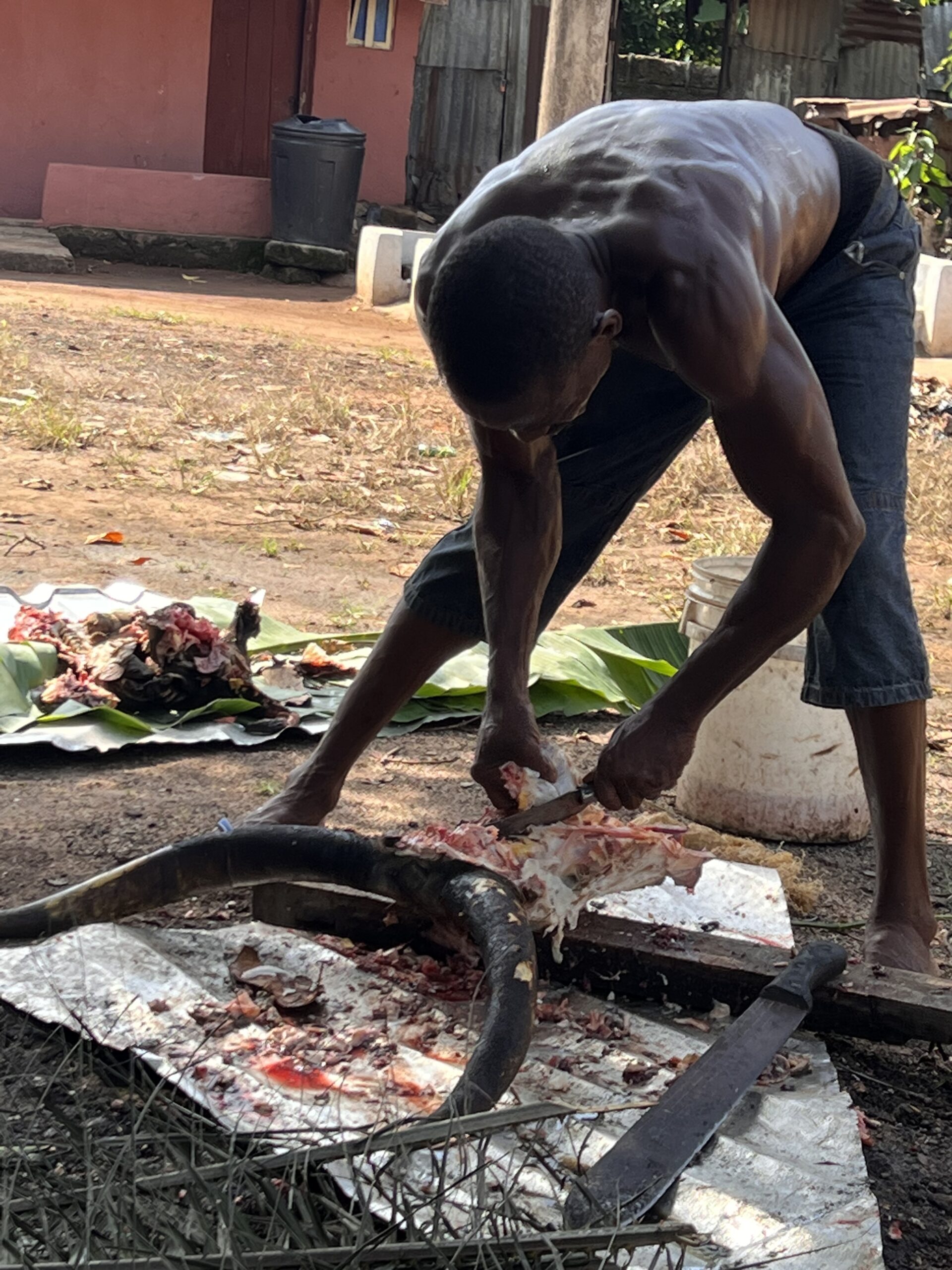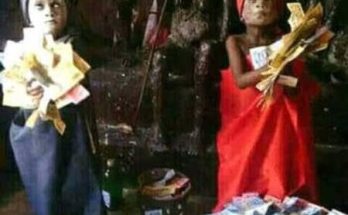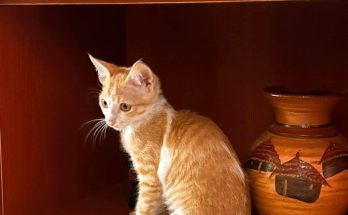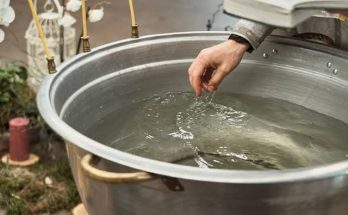In Igbo traditional belief, death is the physical separation of the living from the dead. The people believe in life after death, the idea of resurrection of the dead after death is alien to Igbo traditional thought.
Death, for the Igbo is just a transition into another world of existence (spirit world) which is in continuous relationship with the physical world.
The people always ensure that this relationship with spiritual world is cordial.
Mbiti (1970) observed this view in Africa and wrote: For the Africans, death is a separation and not annihilation: the dead person is suddenly cut off from the human society and yet, the corporate group clings to him.
This is shown through the elaborate funeral rites as well as other methods of keeping in contact with the departed (p.46).

 Also Opoku (1978) corroborated Mbiti’s view and said this about death and funeral in West Africa: West Africa regards death not as the end of life, but as a transition from the present earthly life to another life in the land of the spirits … There is also a widespread belief in Africa that unless the proper rites and ceremonies are performed, the spirit of the dead person may not be able to join the ancestral spirits (pp.133-135).
Also Opoku (1978) corroborated Mbiti’s view and said this about death and funeral in West Africa: West Africa regards death not as the end of life, but as a transition from the present earthly life to another life in the land of the spirits … There is also a widespread belief in Africa that unless the proper rites and ceremonies are performed, the spirit of the dead person may not be able to join the ancestral spirits (pp.133-135).
The people believe that admission of the dead into the spirit world is not automatic. To achieve this for the dead, the children of the dead perform appropriate funeral rites that can facilitate their dead parent(s) into the spirit world.

 In the same way funeral rites in Igboland are not automatic. Many factors determine if one is to be accorded funeral rites. Among the factors are, when and how one dies, marital status of one before he or she dies and if one has a child or children especially male child before he or she dies.
In the same way funeral rites in Igboland are not automatic. Many factors determine if one is to be accorded funeral rites. Among the factors are, when and how one dies, marital status of one before he or she dies and if one has a child or children especially male child before he or she dies.
To support this idea that funeral rites in Igboland is conditional, we make reference to Emeka (1991); “The cases in which many or any major rites are circumscribed with taboo – death by suicide or dreadful diseases, death of infant and people living in alu (abomination)”. (p.18).
Madu (2003) add support to Emaka’s opinion and opined:
The funeral rites given to one depend on: How he died, his age, sex, and status in the communities. The Igbo have both good and bad deaths. A good death implies death after a ripe old age and other parameters while a bad death implies death below this ripe old age or death by detestable diseases. (p.45).
For those who are qualified for funeral rite, their children perform it to ensure peaceful rest to the dead, place or uplift their dead parents in a higher position in the spirit world and finally to avert the wrath of the dead. This belief of the people is in line with the view of Parrnder (1976) when discussing about death rites and said: The great aim of much time and expense is to ensure a proper funeral for the departed, so that his spirit may be contented in the world beyond, and will not return as a dissatisfied ghost to plague his family. Funerals are the last transitional rites, introducing a man into the world of spirit.
 Obilo, (1991) in his own view stressed that funeral rites not perform can result to ancestors striking the living to death. He said “Death can be attributed to have been caused by the ancestors especially if there is any funeral or burial rite yet undone or outstanding in the family” (p.6).
Obilo, (1991) in his own view stressed that funeral rites not perform can result to ancestors striking the living to death. He said “Death can be attributed to have been caused by the ancestors especially if there is any funeral or burial rite yet undone or outstanding in the family” (p.6).
It is in an attempt to place the dead in a higher position in the spirit world that make Nsukka people to include living animal as matters (physical requirements) in the funeral rites which includes fowl, dog, goat, ram, pig, hose, cow etc each having its significance depending on the community.
 Cow which is the thrust of this work is the highest in the above matters and the people believe that it gives the dead the highest position or rank in the spirit world. There are many rituals that surround the use of cow in the funeral rites starting from the presentation of the cow, the slaying and the distribution of the parts of the carcass to the people it belongs to traditionally.
Cow which is the thrust of this work is the highest in the above matters and the people believe that it gives the dead the highest position or rank in the spirit world. There are many rituals that surround the use of cow in the funeral rites starting from the presentation of the cow, the slaying and the distribution of the parts of the carcass to the people it belongs to traditionally.
One of the very important rituals surrounding cow in the funeral rites is the slaying of goat which must precedes the cow. This goat is called Ewu Ngwo Ogodo and must be presented first before the ritual of the cow rite. This goat could be slain many years before the cow or it could be presented and slain the same time.
Process of Cow Ritual in Traditional Funeral Rite Presentation:
The first presentation is done in the house of the person whom the rite is performed for. Here, the children (specifically the first son) will do the ritual presentation of the cow to the umunna, this goes with certain forms where he explains that the purpose is to give honour to whom honour is due, celebrate the legacy the deceased has left behind, demonstrate that they are worthy successors of the deceased, and say how great or strong the parent(s) was.
Songs and Dance: The presentation is followed by ritual song and dance by the umuada.
 The song is thrilled with emotion stating the trials and achievement of the deceased, the smooth journey of the deceased to the ancestral world, the pains and how they will miss the deceased and finally for the deceased to look after them (the children and the relations) from the spirit world and ensure that they remain in peace and love. Handing over the Cow to Onyishi Umunna: After the songs and dances at the deceased house, the cow would be taken to the house of onyishi umunna.
The song is thrilled with emotion stating the trials and achievement of the deceased, the smooth journey of the deceased to the ancestral world, the pains and how they will miss the deceased and finally for the deceased to look after them (the children and the relations) from the spirit world and ensure that they remain in peace and love. Handing over the Cow to Onyishi Umunna: After the songs and dances at the deceased house, the cow would be taken to the house of onyishi umunna.
There they hand the cow over to the onyishi who earlier must have been informed of the cow to enable him tell other onyishi umunna and the village onyishi. After handing over to onyishi, he will show it to the other onyishi and representative of the village onyishi. Note that the village onyishi does not come because of his position and status but sends a representative.
Slaying of the Cow:

 The onyishi umunna gives instruction for the cow to be slain. Then the person who will slay it will come and take it away for slaying.
The onyishi umunna gives instruction for the cow to be slain. Then the person who will slay it will come and take it away for slaying.
The slaying can take place either in the compound of onyishi umunna, in the threshold or anywhere around the house. Before the slaying, the children and even the grand children of the deceased will move away as the tradition requires that children must not be present during the slaying of cow for ones parent(s) funeral rite. When the people have left, the person who is to slain the cow who can be anybody from the umunna who is not owing the parent or anybody funeral cow will take cloth and cover the eyes of the cow and then use knife and slay it.
Immediately after slaying it, the children will come back shouting ritual shout, and hitting stick on the ground asking onye gburu oke eshu nna m or oke eshu nne m meaning who killed my father or my mother’s cow depending if the rite is for father or mother.
Investigations revealed that there are two major reasons why the children of the deceased must not be present during the slaying of the cow. First is the belief that the spirit of one’s dead parents and other relations are present during the slaying ritual and can consciously or unconsciously strike the children may be for not performing the cow ritual on time or for any other mistake or action. Second is the conviction that the cow is the symbol of the dead and therefore one cannot be present where the parent is being slain.
It is also on this credence that the eyes of the cow is covered before slaying because the person performing the ritual slaying do not want the dead person whom the cow represent to see that he is the one doing the slaying.
Division of the Meet:
 After the slaying ritual, another ritual that follows it is the sharing of the carcass. This ritual may have minor differences from one community to another, but it has many things in common.
After the slaying ritual, another ritual that follows it is the sharing of the carcass. This ritual may have minor differences from one community to another, but it has many things in common.
For instance in Ezimo community of Udenu LGA, it is shared as follows; village onyishi = the chest and one leg or one hand, onyishi umunna = one leg or one hand, children of the deceased = the head, one leg or one hand, the skin and the intestine, wives of the umunna = the waist, the person that slain the cow = the cord of the neck close to the head.
The remaining parts after the above sharing are cooked and eaten by everybody present irrespective of where one come from and no limitation, anybody can eat the meat.
 In further ritual of the meat is that the village onyishi will invite all the onyishi umunna to his house to partake in the eating of the chest. The village onyishi will bring some part of the chest and give to them to share. There he will perform the ritual prayers to the ancestors especially the one whom the cow is for his rite.
In further ritual of the meat is that the village onyishi will invite all the onyishi umunna to his house to partake in the eating of the chest. The village onyishi will bring some part of the chest and give to them to share. There he will perform the ritual prayers to the ancestors especially the one whom the cow is for his rite.
Another ritual which is not compulsory is that the head which belong to the children is given to the Ada if she is married, but with the permission of the husband. But if the Ada is not married it then belongs to the entire family.
Note also that the carrying of the cow head by the Ada result to another ritual known as the returning of the Ishi Eshu (cow head). The Ada and her husband family will bring back the skull of the cow.
In this ritual the Ada and her husband family will visit her consanquinal family with a life goat, enough quantity of palm wine, food and cola nuts. The eldest in the consanquinal family will pray to their ancestor and after that the two families will eat and drink together.
 This ritual of returning the skull is very important because if this is not done until the Ada dies, the consanquinal family may decide that she cannot be buried until this ritual is done or if they have mercy and permit the burial, it must be done before her own funeral.
This ritual of returning the skull is very important because if this is not done until the Ada dies, the consanquinal family may decide that she cannot be buried until this ritual is done or if they have mercy and permit the burial, it must be done before her own funeral.
Additional materials from; https://www.ajol.info/index.php/jrhr/article/download/141460/131203




